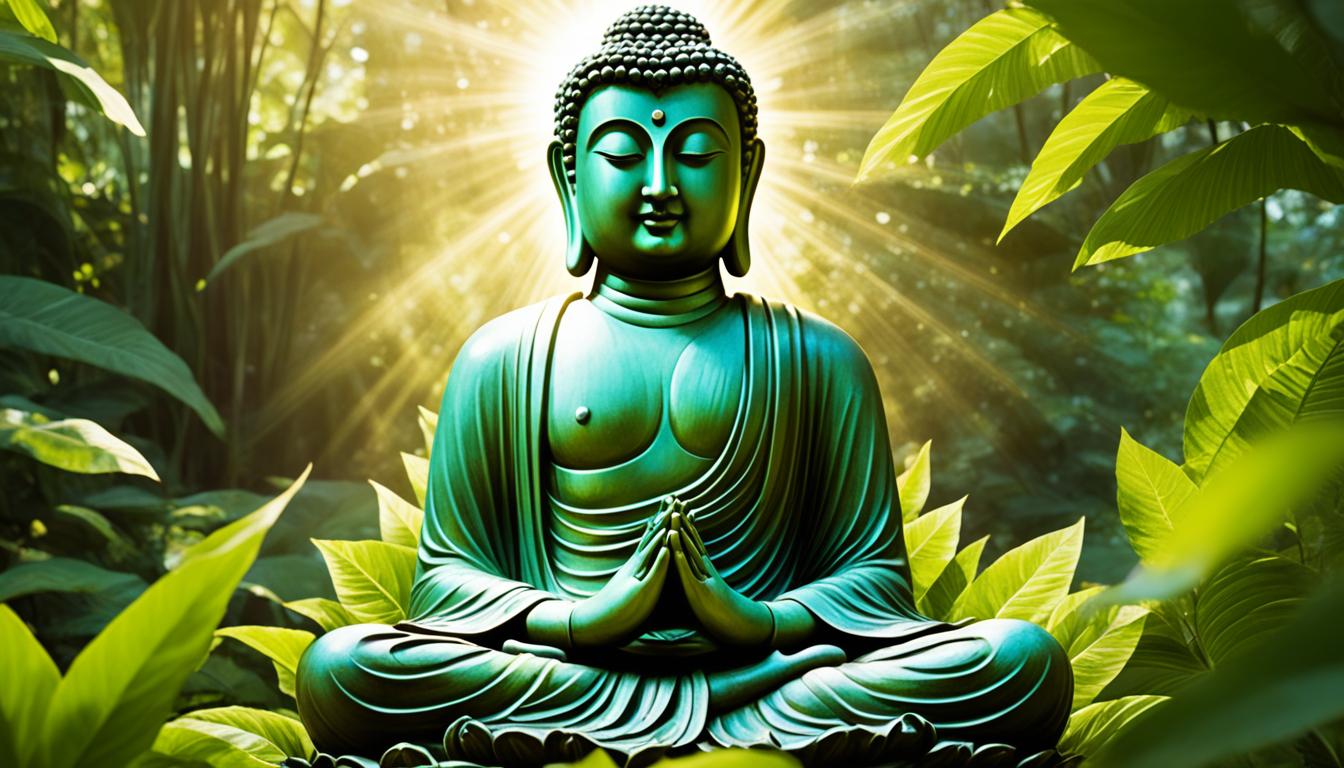“Do not dwell in the past, do not dream of the future, concentrate the mind on the present moment.” – Buddha
Welcome to the world of Buddhism, a spiritual tradition that holds profound insights into the nature of existence and the path to liberation from suffering. Rooted in timeless wisdom and profound teachings, Buddhism offers a unique perspective on life and the human experience. By exploring the basic beliefs of Buddhism, you embark on a transformative journey of self-discovery and mindfulness.
Buddhism, founded by Siddhartha Gautama, the enlightened being known as the Buddha, has attracted millions of followers worldwide. It offers a practical framework for living that promotes compassion, wisdom, and inner peace. The core tenets of Buddhism revolve around the understanding of suffering and the path to its cessation, providing a roadmap to navigate the complexities of life.
In this article, we will delve into the foundational beliefs in Buddhism, exploring the essential teachings, fundamental concepts, and key doctrines that shape this ancient tradition. By understanding the basic principles of Buddhism, you can unlock a deeper understanding of yourself and the world around you. So, let’s embark on this enlightening journey together.
Key Takeaways:
- The basic beliefs of Buddhism revolve around understanding suffering and the path to its cessation.
- The Buddha’s teachings provide a roadmap for living a compassionate, mindful, and purposeful life.
- Buddhism emphasizes the importance of living in the present moment and cultivating inner peace.
- By exploring the foundational beliefs of Buddhism, you can gain insights into the nature of existence and find personal harmony.
- The Four Noble Truths and the Noble Eightfold Path are essential teachings in Buddhism that guide practitioners on their spiritual journey.
The Life and Teachings of the Buddha
Siddhartha Gautama, the historical figure who later became known as the Buddha, renounced his princehood to seek understanding of the human condition. After years of searching and experimenting with different religious practices, he achieved enlightenment, or Nirvana, while meditating beneath a Bodhi tree. The Buddha’s teachings revolved around the Four Noble Truths, which address the nature of suffering and the path to its cessation. He also emphasized the Middle Way, a balanced approach between extreme asceticism and indulgence, and outlined the Eightfold Path as a guide for ethical and spiritual living.

The Buddha’s journey from a privileged life to spiritual awakening inspires countless people to this day. Siddhartha Gautama’s profound insights and teachings provide a roadmap for those seeking inner peace and enlightenment. His path demonstrates that anyone, regardless of their background or status, can find profound truth and meaning in life.
The Buddha’s enlightenment experience under the Bodhi tree represents the pinnacle of spiritual realization. It was during this moment that Siddhartha Gautama gained deep insight into the nature of existence, the causes of suffering, and the path to liberation. His teachings, known as the Dharma, provide guidance and wisdom for individuals seeking to live a virtuous and enlightened life.
Central to the Buddha’s teachings are the Four Noble Truths. These truths offer an understanding of the nature of suffering and the path to its cessation. The First Noble Truth acknowledges that suffering is an inherent part of human existence. The Second Noble Truth explains that desire and ignorance are the root causes of suffering. The Third Noble Truth holds the promise of liberation from suffering, either in this life or through achieving Nirvana. Finally, the Fourth Noble Truth outlines the Eightfold Path as a means to attain the end of suffering.
The Middle Way, advocated by the Buddha, encourages a balanced approach to life. It rejects extreme self-indulgence and self-mortification in favor of a moderate and mindful existence. By avoiding extreme behaviors and cultivating a balanced lifestyle, individuals can navigate life’s challenges and find the path to enlightenment.
The Eightfold Path, also known as the Middle Way, serves as a practical guide for ethical conduct and spiritual cultivation. It consists of eight interconnected aspects: right understanding, right thought, right speech, right action, right livelihood, right effort, right mindfulness, and right concentration. By following these principles, individuals can align their thoughts, words, and actions with wisdom and virtuous intentions.
The Buddha’s teachings transcend time and culture, offering valuable insights into the human condition and the quest for spiritual enlightenment. They continue to inspire millions of people around the world to seek truth, cultivate compassion, and live a life of mindfulness.
The Four Noble Truths
The Four Noble Truths are the core teachings of Buddhism. They convey the understanding that suffering is an inherent part of human existence, and that there is a cause for suffering, as well as a way to end it. 💫
- The First Noble Truth: The presence of suffering.
- The Second Noble Truth: The root causes of suffering are desire and ignorance.
- The Third Noble Truth: The hope of liberation from suffering through achieving Nirvana.
- The Fourth Noble Truth: The Noble Eightfold Path as a means to attain the end of suffering. 🌟
Understanding and embracing the Four Noble Truths are crucial steps on the path to enlightenment and liberation from suffering. By recognizing the reality of suffering, identifying its causes, cultivating the hope of liberation, and following the Noble Eightfold Path, one can find lasting peace and reach the ultimate goal of Buddhism. 🙏
The Noble Eightfold Path
The Noble Eightfold Path is a practical guide for ethical conduct, mental discipline, and wisdom in Buddhism. It encompasses eight interconnected aspects that guide practitioners towards the end of suffering and the realization of enlightenment. By following the Noble Eightfold Path, you cultivate a balanced and skillful way of living that leads to inner transformation and spiritual growth.
Overview of the Noble Eightfold Path:
- Right Understanding: Developing a clear and accurate understanding of life’s true nature and the teachings of Buddhism.
- Right Thought: Cultivating wholesome thoughts and intentions that are free from greed, hatred, and delusion.
- Right Speech: Speaking truthfully, kindly, and compassionately, while avoiding harmful or hurtful words.
- Right Action: Engaging in ethical conduct and refraining from actions that cause harm to oneself or others.
- Right Livelihood: Choosing a livelihood that is honest, ethical, and supports the well-being of oneself and others.
- Right Effort: Cultivating the effort and energy to abandon negative qualities and develop positive ones.
- Right Mindfulness: Developing present-moment awareness and mindfulness in all activities, thoughts, and emotions.
- Right Concentration: Cultivating focused and concentrated mental states through meditation and mental exercises.
By incorporating these aspects into your daily life, you can nurture a deep understanding of yourself and the world, foster positive thoughts and actions, and develop clarity and concentration in your mind. The Noble Eightfold Path is a transformative journey that guides you towards a life of peace, harmony, and spiritual fulfillment.

Karma and the Cycle of Rebirth
In Buddhism, karma plays a significant role in shaping the path of one’s spiritual journey. Karma refers to the law of cause and effect, where every action has consequences that extend beyond the present moment. It is believed that the actions you take in this lifetime, whether good or bad, will have repercussions in the future.
Karma also intertwines with the cycle of rebirth, a concept central to Buddhist philosophy. This cycle suggests that beings are continuously reborn into different realms based on the karma generated through their actions. The realms of existence span six categories, including the fortunate realms and the unfortunate realms.
The fortunate realms encompass the realm of demigods, where beings enjoy power and pleasure; the realm of gods, characterized by divine bliss and tranquility; and the realm of men, our very own human realm. The human realm is considered a rare and precious opportunity for spiritual growth and liberation, granting individuals the potential to achieve enlightenment and break free from the cycle of rebirth.
Conversely, the unfortunate realms consist of the realm of animals, where beings experience instinctual existence; the realm of ghosts, characterized by intense craving and perpetual dissatisfaction; and the realm of hell, marked by extreme suffering and torment.
To visualize the realms of existence and their relationship to one another, refer to the table below:
| Fortunate Realms | Unfortunate Realms |
|---|---|
| Realm of Demigods | Realm of Animals |
| Realm of Gods | Realm of Ghosts |
| Realm of Men | Realm of Hell |
As depicted in the table, the human realm stands as the middle ground between the fortunate and unfortunate realms, offering individuals a unique balance of challenges and opportunities for spiritual growth.
The understanding of karma and the cycle of rebirth reinforces the importance of conscious and ethical actions in the pursuit of enlightenment. By cultivating virtuous karma through acts of compassion, generosity, and mindfulness, individuals can aspire to transcend the limitations of their current existence and progress towards higher realms of consciousness.
Now that you have grasped the significance of karma and the cycle of rebirth, let us delve into the diverse schools of Buddhism in the following section.
Different Schools of Buddhism
Buddhism has evolved into different schools and traditions over time. The three main branches of Buddhism are Mahayana, Theravada, and Vajrayana.
Mahayana Buddhism: Mahayana Buddhism is prevalent in East Asia and emphasizes the role of bodhisattvas and compassion. It emphasizes the idea that all beings have the potential to attain Buddhahood and aims to help others achieve enlightenment. Mahayana Buddhism encourages practitioners to cultivate compassion and engage in practices such as meditation, chanting, and ritual ceremonies.
Theravada Buddhism: Theravada Buddhism is practiced in Southeast Asia, particularly in countries such as Sri Lanka, Thailand, and Myanmar. This school of Buddhism focuses on the monastic lifestyle and meditation. Theravada practitioners believe in the importance of individual effort and the pursuit of enlightenment through mindfulness and insight meditation. The teachings of the Theravada tradition are based on the Pali Canon, the oldest surviving scripture in Buddhism.
Vajrayana Buddhism: Vajrayana Buddhism, also known as Tibetan Buddhism, is prominent in Tibet, Nepal, and Mongolia. This school of Buddhism emphasizes the use of rituals, mantras, and esoteric practices as a means to attain enlightenment. Vajrayana practitioners believe in the power of transformation and utilize various methods such as deity yoga, mandala visualization, and tantric practices to achieve spiritual liberation.
Each school of Buddhism offers its own unique approach to the teachings of the Buddha. While they share a common foundation in the core principles of Buddhism, their practices and philosophical perspectives may vary. Explore the different schools of Buddhism to find the path that resonates with your spiritual journey.
Mahayana Buddhism

| School | Region | Main Emphasis |
|---|---|---|
| Mahayana Buddhism | East Asia | Role of bodhisattvas and compassion |
| Theravada Buddhism | Southeast Asia | Monastic lifestyle and meditation |
| Vajrayana Buddhism | Tibet, Nepal, Mongolia | Rituals and esoteric practices |
The Practice of Meditation
Meditation is an integral part of Buddhist practice. It is a transformative practice that allows individuals to cultivate inner stillness, develop insight, and achieve a state of enlightenment and liberation from suffering. Through meditation, practitioners can gain a deeper understanding of themselves, overcome negative mental states, and cultivate mindfulness, concentration, and wisdom.
There are various forms of meditation in Buddhism, each focusing on different techniques and approaches. Some of the most commonly practiced forms include:
- Sitting Meditation: This form of meditation involves finding a quiet and comfortable space to sit in a cross-legged position or on a chair. Practitioners focus their attention on their breath, bodily sensations, or an object, cultivating a calm and focused state of mind.
- Walking Meditation: Walking meditation is practiced by taking slow, mindful steps while maintaining awareness of each movement. This form of meditation encourages practitioners to be fully present in the moment and to observe their thoughts, feelings, and surroundings.
- Chanting: Chanting is another form of meditation where practitioners recite sacred chants, mantras, or sutras. The rhythmic repetition of words or phrases helps to calm the mind, deepen concentration, and create a meditative state.
Meditation is not only a personal practice but also a means of cultivating inner peace and compassion. It can be practiced by anyone, regardless of their religious beliefs or background. Through regular meditation practice, individuals can experience a profound sense of inner stillness, clarity, and connectedness.

Conclusion
Buddhism offers a profound and comprehensive philosophical and spiritual framework for understanding the nature of existence and the path to liberation from suffering. The basic beliefs of Buddhism, centered around the Four Noble Truths and the Eightfold Path, provide a roadmap for living a meaningful life with compassion and wisdom.
By acknowledging the reality of suffering and understanding its causes, individuals can begin their journey towards liberation. Through ethical conduct, mental cultivation, and the development of wisdom, the core principles of Buddhism guide practitioners towards personal and societal harmony.
Practices such as meditation and mindfulness play a crucial role in this transformative journey. By cultivating inner stillness and self-awareness, individuals can gain deeper insights into the fundamental concepts of Buddhism and experience inner transformation.
By embracing the essential teachings of Buddhism and incorporating them into our daily lives, we can create a path towards peace, mindfulness, and enlightenment. May your journey through these foundational beliefs in Buddhism lead you to a life of harmony and profound fulfillment.
FAQ
What are the basic beliefs of Buddhism?
The basic beliefs of Buddhism revolve around the Four Noble Truths and the Eightfold Path. These teachings address the nature of suffering, its cause, and the path to its cessation.
Who was the Buddha and what were his teachings?
The Buddha, also known as Siddhartha Gautama, achieved enlightenment and founded Buddhism. His teachings emphasized the Four Noble Truths, the Middle Way, and the Eightfold Path as a guide for ethical and spiritual living.
What are the Four Noble Truths?
The Four Noble Truths recognize the reality of suffering in life, identify desire and ignorance as the root causes of suffering, offer the hope of liberation from suffering, and outline the Noble Eightfold Path as a means to attain the end of suffering.
What is the Noble Eightfold Path?
The Noble Eightfold Path is a practical guide for ethical conduct, mental discipline, and wisdom. It consists of eight interconnected aspects, including right understanding, right thought, right speech, right action, right livelihood, right effort, right mindfulness, and right concentration.
What is karma and the cycle of rebirth?
Karma refers to the law of cause and effect in Buddhism. It is believed that one’s actions, whether good or bad, have consequences in the future. Karma also plays a role in the cycle of rebirth, where beings are continuously born into different realms based on their actions.
What are the different schools of Buddhism?
The three main branches of Buddhism are Mahayana, Theravada, and Vajrayana. Mahayana Buddhism emphasizes the role of bodhisattvas and compassion, Theravada Buddhism focuses on the monastic lifestyle and meditation, and Vajrayana Buddhism emphasizes rituals and esoteric practices.
What is the practice of meditation in Buddhism?
Meditation is an integral part of Buddhist practice. It involves focusing the mind to achieve inner stillness and develop insight. Through various forms of meditation, practitioners seek to cultivate mindfulness, concentration, and wisdom.
What can Buddhism offer for personal and societal harmony?
By embracing the foundational beliefs of Buddhism, individuals can embark on a journey of self-transformation and inner peace. Buddhism offers a profound framework for understanding existence and provides guidance for ethical conduct, mental cultivation, and the development of wisdom.

